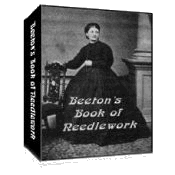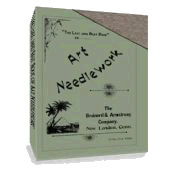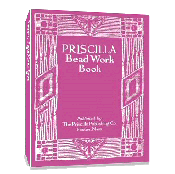Christmas Suggestions for 1885
These helpful Christmas suggestions were published in Harper's Bazaar, December,1885, giving those who were in a quandary what to give their loved ones or friends reprieve from gift-giving uncertainty.
Christmas Suggestions
Edited for use on this site
Perfumed Powder Bags
Very effective and delightful for either the pretty little mahogany of the parlor or my “lady’s” dressing table are the generous bags of perfumed powder, varied to please the one for whom it is intended. They are made of silk soft and shimmery, one of the loveliest being of creamy white, or rather a faint lemon-color, with daisies, looking for all the world as if the first breath of May had wafted them there.
Still another has a dead white background, with buds and blossoms of faintest yellow, a darker shade introduced now and then to give more character to the stuff.
Have a piece half a yard wide and twelve inches long; baste a fine smooth piece of muslin across one end to the depth of seven inches; stitch it on the machine across one end and up the side as far as the muslin reaches. There will now be a bag, the upper sides of which are still unsewed.
Forty-eight inches of any pretty lace — a fine imitation Valenciennes accords well — about two inches in width, is next to be neatly sewn around the open end and sides, first turning in a narrow hem.
Fill the lower half of the bag with one and an eighth pounds of orris root, to which has been added an eighth more of heliotrope and wood-violet. The bag will now be well filled, but not stuffed at all. Tie tightly with stout tape first, putting over it heavy ribbon two inches or a trifle over wide — a yard will be sufficient — and arrange it in an easy-looking bow and ends.
The color of the ribbon should be a darker shade of the silk in the bag. Pull out the frill here and there of the upper part, giving a stitch or two to keep the lace in a careless fashion over the bag.
Fancy-Work Bag
One bag suggests another, and the little trouble and expense of these bewitching affairs intended for fancy-work, or the numberless little adjuncts a woman’s heart delights in, are their own excuse for being. Take one yard each of any handsome ribbon two and a half inches wide — orange, blue, red, and olive form an artistic combination of color — overcast them together as neatly as possible, not their entire length, but leaving a space of five inches at each end. Join the sides to form a bag, keeping the outer seam open in the same manner.
The open or upper end will now consist of eight ends, two of each color; fringe these ends enough to prevent the ragged, unraveled appearance they would otherwise present, and run a casing of inch-wide ribbon across the top part of the bag proper. Four yards of ribbon, three-fourths of an inch wide, are needed for the strings –– a couple of yards each of any two of the colors used in the bag. Run them in so that they will form slip strings, which require two sets of eyelets, one each side of the bag, one set of stings coming out of one, the other opposite. Knot them in long loose loops.
Mantel Clock
It is not for every one to boast of the old mahogany clock of his ancestors, but many a watch, too cumbersome to carry, can, by the friendly aid of a cigar box, become transformed into the quaintest of mantel ornaments. Ten and a quarter inches is quite sufficient for the height, and it is to be divided into three sections — the base, central part containing the door, and the upper for the face.
The measurement for the first is two and a half inches for both width and height, while one and a half will be ample for the depth; on this rests the centre or shaft, which should be four and three-quarter inches high, one and a quarter in depth; the sides of the front are not straight, but sloping a little from the base to the top, and this is their measure — one and seven-eighths inches for the lower, and two-eighths less for the upper end. Two and a half inches give the height for the clock face, while two inches will be sufficient for the width. The base of each division rests on the top of the one below it, excepting the bottom part, which has to have both top and bottom piece of wood.
The clock door may be made as ornamental as one chooses to have it, either with slightly incised work or introduction of thin brass in quaint designs, Studying the main points of a large clock case will be of great advantage in working up the smaller affair, especially noting the slight projection of the bases.
A clever amateur can adjust the works of the watch in place, using a flat crystal for the face if preferred, or the upper part made to fit the watch so neatly that it can be slipped in and out from the top at will.
Have the little curved piece over the top of the face part, and do not omit the sort of clover-like cutting always seen at the top of the door in the centre; it would seem almost like a deception without it. Some of the faces of old-time watches are most beautifully engraved and chased; one especially we recall had a perfect gem in the way of a little Swiss view; another had cherubs while a third was a perfect marvel in its delicate garlands and baskets of flowers. For these any ornamentation in the way of brass-work on the outside of the upper third would be entirely out of place; better have the spindle-shaped supports of wood at each corner that appear to be holding up the roof; this, too, admits of some extra labor in the way of irregular top and suggestion of carving
The heavy silver time-pieces are improved by the addition of brass corners, and a touch of it introduced here and there. The smallest of brass hinges and catches should be put on the doors and if neatly managed, serve as well for use as show As money can not purchase these decidedly original case, they form most acceptable gifts.
A Housewife
Over what a wide distance of years the need of a housewife reaches, welcome alike to the little girl and her grandmother! Dark red satin ribbon makes the richest, and have it an inch and a quarter wide. Form first a careless-looking bow of four loops and a half as many ends; this requires about three-quarters of a yard.
Next cut a length of twenty inches, and another of twenty-seven. Each end of these must be sewed on the wrong side, then turned, which will make them pointed, and present no cut surface to ravel.
For the pincushion, cover two pieces of not too stiff pasteboard one and a half inches in diameter with satin the exact shade of the ribbon, and neatly overseam them together, putting pins around the edge.
Sew the centre of a piece of red silk cord eight inches long on the cushion, fastening the two ends to one of the ribbon points, concealing at the latter place the sewing by a bow and ends of quarter-inch ribbon; another piece of this narrow ribbon passes across the cushion, and ties at the opposite edge from the cord. The same point holds a satin bag two inches square, made with heading and narrow ribbon for drawing, in which is placed the thimble.
The needle-book depends from the second point, and is made as daintily as all the rest The silk cord straps in the flannel. Each cover is two inches by two and a half, and lattice-work stitches of sewing silk join it at the back.
The scissors sheath should be as long as the pair selected, and is joined at sides and narrow end in the same manner as the needle-book. Two and a half inches long, a scant inch at top, and half the size at bottom gives a good proportion for the sides. Three pieces of cord are needed here – two, or rather a double piece, to knot on the scissors, and a single strand to be attached to the sheath.
Each side of the emery cushion is one and three-quarters by one and a quarter inches, and the cord and ribbon pass at one end and across as in the pincushion. The ribbons are securely sewed to the back of the bow, but are first pinned in order to make them hang at irregular lengths The same stitches will answer for a large smoothly made safety-pin with which the housewife is fastened to the waist.
For variety a combination of color is often effective, as dark and light rose ribbon, or the contrast of pink and blue; but as the neatness of these articles either makes or mars them, see that the ends are all nicely finished, and the sewing silks exactly match the materials on which they are used.
Tribe of Monkeys
It is to be hoped the family for whom they were intended will have as much jollification out of a tribe of monkeys as the donors have already had in their making. They were the most obliging of creatures, swinging by either one arm or two on a pencil, dancing and jumping on a palm-leaf fan, at the will of any one who may practice them, for they are so light they bounce like rubber.
Chenille is difficult to measure, but for the body choose the wired kind that is close and well made, and, as near as the tape will give the size, two and a half inches around. Dull red is a good color, using old-gold for the legs and arms. If a very bizarre effect is desired, combine red and white or blue and red. Where the family is extensive, it is just as well to give a variety to their dress.
The body, head, and tail require eight inches; take two and a half inches for the head, doubling the end nearly over, and pressing firmly together the loop thus formed; trim with a sharp pair of scissors until thin enough to form the nose; the abrupt bulging of the rest gives the retreating forehead. Shear almost to the wire three inches at the other end, and the tail will be done: this leaves the central part plump for the body. Six inches of the next smaller sized chenille are for the legs, the shearing of which must be graded; a quarter of an inch very much clipped gives the foot; then one and three-eighths, sloped to half the original thickness of chenille, gives from the ankle to the knee; the rest of it the upper part, excepting enough to wrap around and keep in place where the body commences.
The arms take six inches ore, and are wrapped once tightly around the neck. Fluff the chenille around the head, putting two white beads with a little mucilage for the eyes. Bend the chenille into shape for the limbs, handling lightly to avoid crushing. It is in this, as everything else, a little practice is needed to make them successfully. Bend the end of the tail at right angles to the rest a fill inch and a half; this with the feet balances the animal.
Ornamental and Useful Fan
Hanging at one side of a handsome chimney-piece, with its bewitching tiles and open fire, is a delicate Japanese fan that has been adapted to the useful as well as ornamental. The ground is silvery gray; it is transparent like thin mica, and its upper edge shot with silver lines and flecked with dots suggestive of the sky the almond-eyed workers delight to simulate. Delicate apple blossoms in light and bright pink, with their stems in gold, among which a few brown birds are flitting, complete the decoration.
Take out the little wire that holds the sticks at the lower end; these sticks measured just five inches from end to paper, and in and out them apricot satin ribbon an inch and three-quarters was run; two tiers, the one of the lower row alternating with the stick taken up of the preceding row. Conceal and confine the ends of the sticks in a little bag-like affair of the ribbon. Make from thin pasteboard a cornucopia to fit at the back and give support to the fan; it measures five and a half inches across the top, covers half an inch below the upper edge of the fan, its lower and terminating in a point. Sew the sides neatly together; then gum on half a yard of ribbon for the handle, put in quite an inch below the top and on the outside of the cornucopia. Gum the latter to the fan, making it lap one fold; put a bow of ribbon on one side of the covering at the end of the sticks, and a large on in the middle of the front: there should be four three-inch loops, and as many three and four inch fish-tail ends. The stitching of this bow in place keeps the fan and lining tougher, no other arranging being necessary.
Large Pillows
Answering equally well for the lounge in winter and hammock in summer are the large pillows that are both comfortable and ornamental. Make the large square down-filled cushion of either Turkey red or Bolton sheeting dyed a lovely blue; it is in the cover one’s taste and deftness show themselves. Such delicate silver gray and creamy lines as comes for the purpose! — some plain, others with a diagonal twill. One way is to make four squares, joined with a heavy torchon insertion, finishing at the edge with corresponding lace.
Another divides the solid piece into squares by effective drawn-work; but in either case the linen should be cut smaller than the cushion, that a line of color ay show beyond as well as through the bars of open-work.
Disks, sprays of flowers, or geometrical designs are to be worked with either linen floss or some of the washable silks, excepting filo-floss or filloselle, which roughen in washing. At each corner and in the middle of the sides bows of ribbon are to be placed; or if a simpler form is desired, tack the outside cover and pillow together.
Large Beautifully Ornamented Jar
To hold the great bunches of both ostrich and pampas grasses a friend had collected for winter use, a graceful-shaped huge stone jar of trifling cost was painted with white and Naples yellow a creamy white, coat after coat put on, then rubbed and smoothed, as any better grade of housepainter will tell you how, if you ask him right.
It was one of the handsome expensive English jars, covered with flowers and leaves in gold, that was to be reproduced. Having taken the largest sheets of sand-paper, and gilded them, great sprays of blackberry leaves and flowers were cut from the gilded paper and glued on. Apple blossoms, hawthorn, dogwood, wild-rose, and delicate creeper would be very effective.
First cut the design in tissue-paper, making as large a section as possible; this is to be gummed to the back of the sand-paper, following the outlines with a pair of sharp scissors. The only care needed is to keep it from cracking.
If a colored design is wanted, paint the sand-paper: brown would be lovely, using some white varnish in mixing, and while moist sprinkling with coarse diamond-dust. Conventionalized flowers may be used, forming a border at both top and bottom, if desired, then bring in the sprays, branches and blossoms as if springing from them. But any arrangement will be found wonderfully pretty and effective.
Return to top of Christmas Suggestions for 1885 page.
Return to Victorian Christmas page.
The Last and Best Book of Art Needlework
Over 100 pages of authentic Victorian instructions and patterns from 1895!
FREE
Beeton's Book Of Needlework

433 pages!
Sign up for VEAC! Everything you wanted to know about Victorian embroidery, needlework, crafts and more!
Priscilla Bead Work Book
Make Beautiful Victorian Beaded Purses, Jewelry & Accessories - Starting
TODAY!



